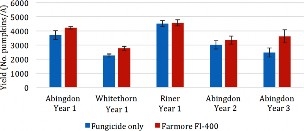Benefits of an Insecticide Seed Treatment for Cucurbit Production
ID
ENTO-456NP
Introduction
Cucurbit growers in the Mid-Atlantic U.S. can purchase their seeds pre-treated with the neonicotinoid insecticide thiamethoxam (Cruiser 5FS®). The insecticide seed treatment is FarMore F1400, which also includes three proven and complementary fungicides that provide the first line of defense against several key seed and seedling diseases including Rhizoctonia, Fusarium, Pythium, general damping-off, and seedling blight. However, as the use of neonicotinoids has become controversial, particularly as it relates to pollinator protection issues, some growers have asked whether thiamethoxam is needed. In this bulletin, we hope to provide some information that might be helpful to answer that question.
Before the registration of FarMore DI-400 (now FI400®) seed treatment in the late 2000s, researchers from Cornell University, University of Delaware, University of Maryland, Ohio State University, and Virginia Tech evaluated the efficacy of neonicotinoid seed treatments on cucurbits and showed that thiamethoxam seed treatments provided effective control of cucumber beetles (the primary target pest) for up to 3 weeks following planting.
Compared with the typical control strategies that were used for cucumber beetles in the early 2000s, such as in-furrow applications of Furadan 4F, neonicotinoid transplant drenches, or weekly foliar sprays of pyrethroids, the thiamethoxam seed treatment provides a similar level of protection against excessive foliage damage in young plants, but at a tiny fraction of the amount of insecticide applied to the environment.
FarMore FI400 uses thiamethoxan at 0.164 pounds of active ingredient per acre or 1.3 mg of active ingredient per seed (based on pickling cucumbers per acre), whereas the recommended rate for soil drench is 0.38 pounds of active ingredient per acre which is double the rate of the FI400 seed treatment. Additional research showed that the insecticide residues are lower in the reproductive structures of the plant when applied as a seed treatment, and would consequently not have deleterious effects on pollinators. Most of the insecticides applied as a foliar spray such as pyrethroids, neonicotinoids, or Sevin; however, are potentially harmful to bees due to higher amounts of insecticidal residues being translocated to nectar and pollen.
The seed treatment is relatively cheap and has become widely used by growers as the first line of defense against cucumber beetles. The difference in costs between non-treated seeds and seeds treated with FarMore can vary from as little as $1 (pickling cucumbers) to $15 (some pumpkin cultivars). Cucumber beetles are not always pests of pumpkins as that crop can quickly outgrow beetle feeding injury and pumpkins are not preferred by the beetles compared to other cucurbits like blue hubbard squash, cucumbers, or various muskmelons.
A three-year farm study on the benefits of FarMore FI400 seed treatment compared fungicides alone and FI400 treatments on pumpkins in the absence or presence of cucumber beetle pressure. We were hoping to determine any other benefits of that seed treatment if the cucumber beetles are out of the equation. Experiments were conducted at five locations in Washington and Montgomery counties. Plots planted with FI400 treated seeds were compared with plots planted with fungicide-only treated seeds in a completely randomized design. Pumpkins were harvested and yield was extrapolated out to a per-acre basis as shown in Figure 1.

Without significant cucumber beetle pressure, plots planted using the FarMore FI400 seed treatment had similar if not greater yield year after year, regardless of the site, compared with the fungicide-only seed treatment (Fig. 1). Other trials have shown a reduction in cucumber beetle presence and damage in plots treated with the FI400 seed treatment. Removing early season sprays for cucumber beetle by using a seed treatment instead could reduce pest management costs.
Additionally, any of the traditional insecticides used during these early sprays are broad-spectrum and may cause injury to beneficial insects and risk of flaring aphids in the field. Thus, reducing early pyrethroid sprays may also reduce the need to use expensive aphicides later on. In these trials, no pest pressure justified any treatment beyond planting seed treatment with FI400. The reduction of insecticide sprays in favor of seed treatment can have significant cost savings on a per-acre basis without having to sacrifice yields.
References
Chan, D.S.W. and N.E. Raine. 2021. “Population decline in a ground‑nesting solitary squash bee (Eucera pruinosa) following exposure to a neonicotinoid insecticide-treated crop (Cucurbita pepo).” Nature, Scientific Reports 11: 4241, doi.org/10.1038/s41598-021-83341-7
Kamel, A. 2012. “Insecticide Residues in Pollen and Nectar of a Cucurbit Crop and Their Potential Exposure to Pollinators.” Journal of Agricultural and Food Chemistry 60: 4449-4456
Stoner, K.A., and B.D. Eitzer. 2012. “Movement of Soil-Applied Imidacloprid and Thiamethoxam into Nectar and Pollen of Squash (Cucurbita pepo).” PloS ONE 7(6): e39114.
Virginia Cooperative Extension materials are available for public use, reprint, or citation without further permission, provided the use includes credit to the author and to Virginia Cooperative Extension, Virginia Tech, and Virginia State University.
Virginia Cooperative Extension is a partnership of Virginia Tech, Virginia State University, the U.S. Department of Agriculture (USDA), and local governments, and is an equal opportunity employer. For the full non-discrimination statement, please visit ext.vt.edu/accessibility.
Publication Date
October 14, 2021



